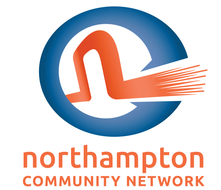Jeff Christensen of EntryPoint Networks spoke Thursday night at FreePress in Florence. His topic: how to build municipal networks right. The two-hour meeting was taped by Northampton Community TV and attracted a number of people from outside of Northampton curious to hear him speak. After the video is edited and posted, we’ll make available a link to the full presentation.
EntryPoint Networks is helping communities create municipal networks that are robust and open to multiple service providers. They provide software to manage these networks. There are a few key points to their proposed architecture:
- The city or town first needs to provide the high-speed digital infrastructure. This can be thought of as infrastructure as a service. Typically this means a one-gigabit per second fiber optic connection to each residential unit and business.
- Then one or more service providers provide internet and related services on the infrastructure. All of these providers provide connection to the broader Internet for anyone who wants to subscribe to their service. For example, one provider might provide 100 megabits per second service for $9.99/month. Service providers can distinguish themselves by offering features and/or content or by price. For example, one provider might offer a static IP (internet protocol) address at no additional charge, or content bundles, such as a Netflix-Hulu combination with their monthly fee. Another might provide 1 gigabit per second for $19.99/month but without static IPs or bundling any additional content. The reason they can offer these low prices is because they don’t have to deploy and manage the infrastructure in the community. If you don’t like the service you are getting or feel you can get a better deal, you pick another service provider from the city’s portal.
- Everyone pays a monthly maintenance & operations expense. This is your share of the cost to keep the infrastructure running. It pays for a center with all the machines to run the network, to maintain the network optical fiber on various telephone poles and underground, for maintaining connections to the network and to the home or business, and keeping the network viable indefinitely for the community.
- Everyone pays a monthly infrastructure expense, your share of the cost to build the network. So if a network cost $10M to build for 10,000 businesses and residences, the cost is $1000 each. You pay a portion of the $1000 every month until the amount is paid off, or you can write a check for $1000 and never pay this monthly fee. When paid off, the household becomes an owner of the network. This ownership conveys when the property is sold. This approach also limit’s the city’s financial liabilities.
In the city of Ammon, Idaho which is using this model, a typical bill is as follows:
- $17.00 for monthly infrastructure expense
- $16.50 for monthly maintenance and operations expenses
- $9.99 to a service provider for 100 megabits per second symmetrical connection to the internet
In this case, the total bill is $43.49/month, or just $26.49/month is your pay your entire monthly infrastructure expense as a lump sum.
For comparison purposes, here in Northampton, Comcast charges $84.95 for an “up to” 100 megabits per second download speed, with upload speeds capped at “up to” 5 megabits per second. So if the Ammon, Idaho model and pricing structure could be adopted here in Northampton, a subscriber would save 51% while having twenty times the upload speeds and a likely consistent 100 megabit per second upload/download speeds. With Comcast of course you can only rent their service, never own a part of it and have no say in the prices they charge or leverage in the quality of service they provide.
There was much more in Jeff’s talk we may summarize in future posts.
Sounds good to us! Sign us up! We hope that Mayor Narkewicz begins a study of a community network here in Northampton as soon as possible in Fiscal Year 2020 (which starts July 1, 2019) and seriously considers this governance and implementation model for Northampton residents and businesses.

Here’s an article discussing the differences between Dark Fiber open access and Lit Fiber open access. Ammon is the Lit model powered by EntryPoint. A hybrid Dark and Lit model should be considered as the civil infrastructure for Northhampton, and any city/town.
https://www.isemag.com/2018/06/p3s-business-models-2/